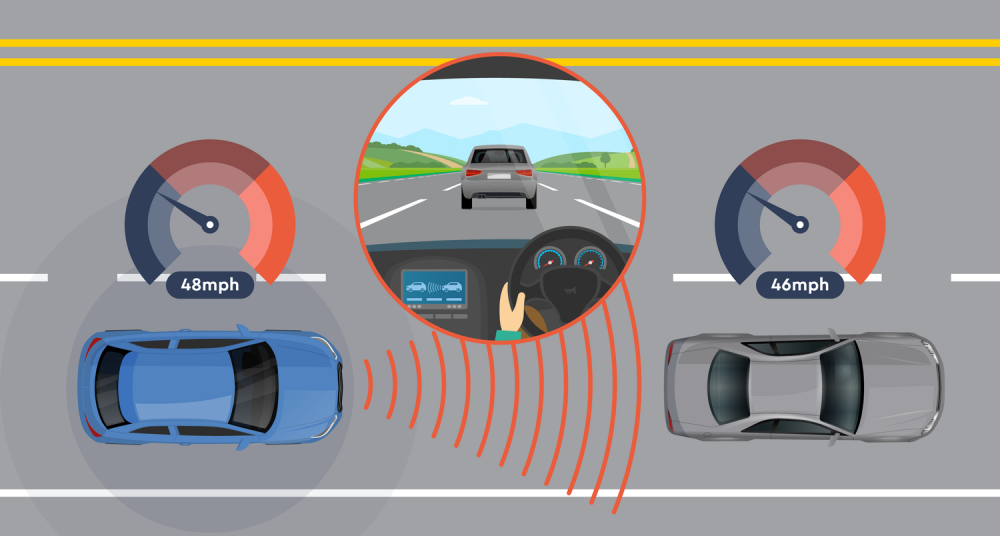How Adaptive Speed Control Reduces Accidents and Insurance Costs
May 31, 2025 Resolute Dynamics

Road safety isn’t optional—especially if you manage a fleet. With traffic growing and margins thinning, relying on gut instinct alone won’t cut it anymore. Smarter tools are out there, and one of the most practical is adaptive speed control.
This system does more than rein in speed. It steps in when attention slips, keeps risk down, and even chips away at insurance costs. Less guesswork. More consistency. Real impact.
Let’s break it down—how it works, and why your fleet should care.
✅Key Takeaway:
Adaptive speed control relies on radar, cameras, and smart processing to tweak vehicle speed based on traffic flow and road changes. It helps cut collisions, save fuel, and ease driver strain. For fleets, it brings safer trips, lower insurance bills, and smoother logistics—making it a smart move for staying sharp and compliant.
What Is Adaptive Speed Control?

Adaptive Speed Control—also known as Adaptive Cruise Control (ACC)—isn’t your basic set-it-and-forget-it system. It reads the road and reacts. Traffic slows? The system backs off. Things open up? It gets you moving again.
No constant input. No delayed responses. Just smoother driving with fewer surprises.
Unlike old-school cruise control that sticks to one speed no matter what’s ahead, ACC keeps its eyes open. It slows down when needed. Picks up again when it’s safe. All without tapping the brake or gas.
This is all made possible thanks to a blend of onboard tech, including:
-
Radar sensors (usually mounted on the front grille)
-
Forward-facing cameras (often placed near the windshield)
-
Ultrasonic sensors and LiDAR (in some advanced models)
-
ECUs (Electronic Control Units) to process sensor data
These components work as a team. They monitor the speed and distance of vehicles ahead, constantly adjusting based on what’s happening in traffic.
If the car in front slows down, the system responds—either by easing off the throttle or tapping the brakes. When the road clears, it brings you back up to your chosen speed. No sudden moves. No guesswork. Just a smoother drive with fewer surprises.
Key Features of Adaptive Speed Control:
📌 Automatic Distance Control
The system maintains a safe headway distance (the time gap between your vehicle and the one in front), typically adjustable by the driver—e.g., 1, 2, or 3 seconds.
📌 Stop-and-Go Functionality
More advanced systems take it a step further. Found in many commercial fleets and high-end vehicles, they can bring the vehicle to a full stop in traffic—and then get moving again once it’s safe.
This feature’s often labeled Traffic Jam Assist or Stop-and-Go ACC. It’s made for the daily grind—those stretches of traffic that test patience and waste fuel. By handling the stop-start routine automatically, it keeps drivers fresher and vehicles more efficient.
📌 Speed Modulation Based on Road Conditions
Some systems don’t just react to traffic—they listen to the road itself. Using cameras or GPS data, they recognize speed limits and adjust accordingly, without any driver input.
This is called Intelligent Speed Assistance, or ISA. It takes one more task off the driver’s plate—and cuts down the chances of an unexpected ticket or worse.
How It Enhances Driver Safety and Comfort
Adaptive speed control plays a crucial role in reducing driver fatigue, especially on long highway trips or in stop-and-go traffic. It supports:
-
Smoother braking and acceleration
-
Consistent following distance
-
Fewer instances of tailgating or harsh braking
The result? Better reaction times, lower stress, and more attention on what’s happening around the vehicle—not just on the pedals.
For fleet operators, that translates to more consistent driving across the board. Less brake abuse. Fewer hard stops. And a noticeable drop in aggressive driving behavior.
Related Technologies That Work With Adaptive Speed Control
Adaptive speed control often operates alongside other ADAS (Advanced Driver Assistance Systems), such as:
-
Forward Collision Warning (FCW)
-
Automatic Emergency Braking (AEB)
-
Lane Keeping Assist (LKA)
-
Driver Monitoring Systems (DMS)
When integrated together—as seen in solutions by companies like Resolute Dynamics—these technologies form a predictive safety ecosystem that helps vehicles not just react, but anticipate and prevent risky situations.
How Adaptive Speed Control Prevents Accidents

Most crashes don’t come out of the blue. Over 90% are linked to human error—speeding, tailgating, late reactions, or just not paying attention.
Adaptive speed control tackles these head-on. It adds real-time, AI-powered decision-making to the mix. The system doesn’t get tired, distracted, or impatient—and that alone helps take a big chunk of risk off the table.
Think of it as a co-pilot with perfect focus—it watches the road, calculates safe distances, and adjusts your speed faster than any human can.
1. Automatic Braking: Reacts Before You Can
One of the most critical safety features is automatic deceleration. If a vehicle up ahead suddenly slows down or stops, the adaptive system will reduce your speed instantly—often before the human driver even moves their foot.
This is powered by:
-
Forward-facing radar to detect objects and their speed
-
AI algorithms to calculate braking force and timing
-
Electronic Stability Control (ESC) systems to ensure safe deceleration
This rapid reaction helps avoid rear-end collisions, which are among the most common types of road accidents.
2. Safe Distance Monitoring: Ends the Guesswork
Most drivers don’t accurately judge safe following distances, especially at high speeds. Adaptive speed control fixes this by automatically keeping a constant time gap between vehicles.
This is based on:
-
Speed
-
Road conditions
-
Driver-set preferences (usually 1–3 seconds)
If the car in front slows, the system backs off to maintain a safe cushion. If the road clears, it gently speeds back up.
This consistency reduces the risk of:
-
Tailgating
-
Panic braking
-
Domino-effect pileups in dense traffic
3. Smooth Driving Patterns: Prevents Aggressive Maneuvers
Jerky acceleration and braking are not just uncomfortable—they’re dangerous. They increase:
-
Brake wear
-
Fuel consumption
-
Risk of sudden-impact collisions
Adaptive speed control ensures gradual, predictive adjustments to speed, creating a smoother traffic flow. For fleets, this also promotes:
-
Lower vehicle maintenance costs
-
Better driver comfort
-
Fewer instances of “stop-start fatigue”
A smooth vehicle is a safe vehicle—and that benefits everyone on the road.
4. Integration with Vision Systems: Sees What You Miss
Some advanced adaptive systems go beyond just radar and sensors—they use vision-based AI to interpret road signs, lane markings, and even driver attentiveness.
This means the system can:
-
Recognize speed limit changes and adjust accordingly
-
Detect road curvature and prepare speed for safe cornering
-
Identify risky behaviors (like drowsy driving) and activate alerts
-
Anticipate merging or lane-change scenarios in traffic
Resolute Dynamics, for example, combines adaptive speed control with vision systems, machine learning, and real-time telematics to create a fully integrated safety ecosystem. This makes accident prevention more proactive than reactive.
Real-World Scenarios Where It Makes a Difference
Let’s look at where adaptive speed control shines the most:
Urban Driving
-
Handles frequent stop-and-go traffic
-
Prevents rear-end fender benders
-
Helps maintain safe gaps in busy intersections
Highway Cruising
-
Maintains consistent speed and spacing
-
Prevents driver fatigue on long routes
-
Responds to sudden lane changes by other vehicles
Fleet and Commercial Use
-
Reduces accident frequency across large vehicle networks
-
Tracks incident data for analysis and training
-
Keeps compliance with speed regulations automatically
Impact on Insurance Costs

Insurance companies love vehicles with safety features—and adaptive speed control is a favorite. Why? Because fewer accidents mean fewer claims.
Here’s how it helps lower insurance premiums:
-
Risk-Based Pricing: Insurers use telematics data to assess driver risk. Adaptive speed control helps keep that risk score low.
-
Fewer Collisions: Rear-ends, fender-benders, close calls—adaptive systems cut them down by reacting faster than most humans can. Fewer repairs. Less downtime. Fewer angry phone calls.
-
Safer Fleets, Bigger Discounts: Insurers are paying attention. Some now offer discounts to fleets using ADAS tech, including adaptive speed control. Safer driving isn’t just smart—it’s financially rewarding.
-
Claims Prevention: With real-time data, many adaptive systems can verify what happened during an incident, making claims more accurate and sometimes preventing false liability.
Fleet operators who use adaptive speed control often see a noticeable dip in insurance costs within the first year of adoption.
Resolute Dynamics’ Role in Speed Compliance Innovation
Resolute Dynamics is at the forefront of AI-powered automotive safety. Their control systems are more than just speed governors—they’re intelligent platforms that respond to real-world conditions in milliseconds.
Here’s what sets them apart:
-
AI-Powered Controls: These systems don’t just react—they learn. Driver habits, traffic flow, and environmental inputs all feed into smarter, faster decisions behind the wheel.
-
Real-Time Telematics: Each vehicle becomes a live stream of data. Speed, location, behavior—everything feeds back in real time to boost safety and keep your operation in check.
-
Fleet-Wide Intelligence: Ten vehicles or ten thousand—it doesn’t matter. Their platform applies consistent oversight across your fleet, keeping every unit aligned with safety standards and speed rules.
-
Global Reach: With more than 200,000 vehicles connected across the UAE, MENA, and Asia, Resolute Dynamics isn’t just in the game—they’re shaping it.
Their systems combine adaptive speed control, machine learning, and vision AI into one seamless solution. This is not just safety tech—it’s predictive safety.
Benefits for Fleet Operators
For companies managing large or small fleets, the benefits of adopting adaptive speed control go far beyond safety:
-
Reduced Accident Rates: Fewer accidents mean less downtime and fewer repair bills.
-
Insurance Savings: Insurers reward fleets that use smart control systems.
-
Improved Driver Accountability: Telematics data helps track driver behavior and performance.
-
Fuel Efficiency: Smooth driving patterns lead to better fuel economy.
-
Regulatory Compliance: Stay in line with local and international road safety standards.
All these add up to one thing: higher profit margins with lower risk.
FAQs
Q: Is adaptive speed control the same as emergency braking?
No. Emergency braking is a sudden stop when a collision is unavoidable. Adaptive speed control prevents you from getting into that situation in the first place by adjusting speed earlier.
Q: Can older vehicles be upgraded with this tech?
In many cases, yes. Resolute Dynamics offers retrofit solutions for legacy fleets.
Q: How much can fleets save on insurance?
While it depends on your insurer, fleets often report 10–25% savings after implementing adaptive safety features.
Final Thoughts
Being careful on the road helps—but being equipped is smarter.
Adaptive speed control isn’t a nice-to-have anymore. It’s a frontline defense against accidents, insurance spikes, and unpredictable driver behavior. For fleet operators, it’s a move that makes sense on paper and on pavement.
Want fewer repair calls and more uptime? Want drivers who come back less stressed and more consistent? This is the kind of tech that gets you there.
And if you’re serious about rolling it out at scale, Resolute Dynamics has the tools and track record to back it up. Over 200,000 vehicles already trust them. Might be time to add yours to the list.
Smarter speed. Safer roads. Stronger fleets.